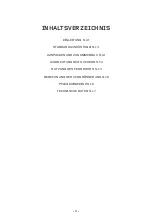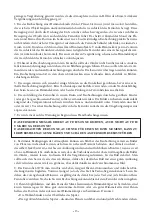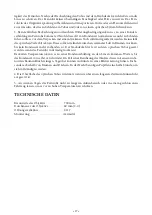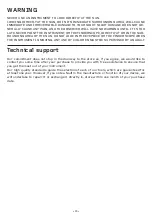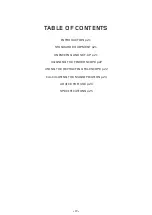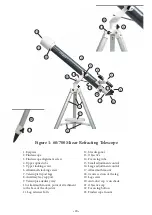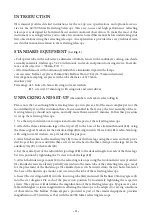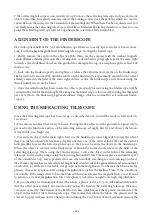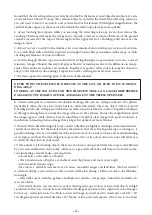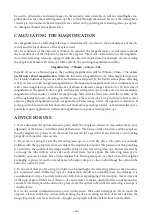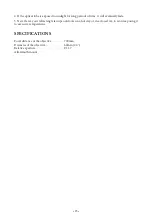
• 24 •
be used to obtain clear and sharp images. In the majority, terrestrial objects will not stand higher ma-
gnification because the refracting telescope has to look through the densest layers of the atmosphere,
contrary to astronomical observations that are carried out by pointing the refracting telescope upwar-
ds, through a thinner atmospheric layer.
CALCULATING THE MAGNIFICATION
The magnification of a refracting telescope is determined by two factors: the focal distance of the ob-
jective and the focal distance of the eyepiece used.
The focal distance of the objective is 700mm. To calculate the magnification, you will need to divide
the focal distance of the objective by that of the eyepiece. The result of this division is the magnifica-
tion of the refracting telescope equipped with the objective in question. For example, if you are using
the eyepiece K 25mm with telescope Mizar 60/700, the resulting magnification will be:
Magnification = 700mm ÷ 25mm = 28x
Equally, if you use a 9mm eyepiece, the resulting magnification will be 700mm ÷ 9mm = 78x. A few
useful notes about magnification While the theoretical magnification of a refracting telescope may
be virtually unlimited, in practise there are limitations imposed by the Earth’s atmosphere, affecting
what you can see with any given magnification. The maximum magnification most commonly used
with a refracting telescope with an objective of 60mm in diameter, ranges from 80 to 120. In terms of
magnification, the general rule to apply with any refracting telescope is: only ever use the maximum
magnification that ensures a stable and sharp image. This criteria often varies with the stability of the
air through which you are observing, and that is one of the reasons why it is a good idea to have several
eyepieces. Higher magnification does not guarantee a better image: in fact, the opposite is often true. It
is also good to bear in mind that observation of the landscape and open fields, or the interstellar space,
generally require applications with weak magnification on your refracting telescope.
ADVICE FOR USE
1. Never dismantle the optical elements, particularly the eyepieces: when you reassemble them, poor
alignment of the lenses could affect their performance. The lenses on the objectives and the eyepieces
must be aligned: it is precise work, that must be reserved for a specialist. If any element is not working
properly, call our after-sales service.
2. If you are not using it, store the refracting telescope in a cool, dry place. The optics are carefully
polished with the appropriate curve to achieve the required focal point. The precision of this polishing
is essential to the quality of the image and the value of your refracting telescope. Protect the lens by
re-closing the tube with its cover after each observation. Never expose the refracting telescope to
humidity or excessive heat. Store in the original box. During transport, use the box and the original
packaging to protect it and be careful never to bump or drop it, as this could damage the optical tube
and/or its optical system.
3. In the event that you are using it outside on a humid night, the refracting telescope may accumu-
late condensed water. While this type of condensation should not normally cause any damage, it is
recommended to wipe it entirely with a dry cloth, before repackaging it for transport. Never wipe any
of the optical parts. Rather leave them to dry in warmer air, inside, until all of the condensation has
vanished. The dust guard should not be placed over the optical tube until the refracting telescope is
completely dry.
If it is cold outside, condensation may occur on the lenses. Wait until it disappears. If you touch the
eyepiece, clean it with a dry, cotton cloth. During the day, ascending currents of air may deform the
image. Especially over trees and roofs. At night, your pupils will take half an hour to fully dilate.
Summary of Contents for LUNETTE MIZAR 60/700
Page 2: ... 2 ...


